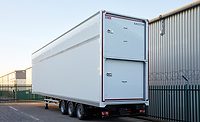Dow Auto: A Lighter Load

Structural bonding in the automotive industry has evolved significantly since its early use in the 1990s. Originally, adhesives were primarily used to complement spot welds to provide sealing and corrosion protection. However, advancements in material chemistry, application and process know-how have led to broader use and dependency upon adhesives to provide body stiffness improvement, body stiffness retention, long-term durability, and improved safety performance.
The changes in the automotive industry landscape, in combination with regulatory requirements and insurance ratings (such as the Insurance Institute for Highway Safety [IIHS] side impact and enhanced roof crush), have challenged original equipment manufacturers (OEMs) to develop innovative mass-efficient body structure designs that not only meet more stringent safety requirements, but also provide the design flexibility to assemble multiple vehicle designs on one vehicle platform.

Enhancements in structural bonding technologies have also enabled OEMs to successfully integrate dissimilar materials, such as magnesium, aluminum, carbon fiber laminates and different grades of steel, to obtain optimal structural efficiency and strength-to-weight ratio. In addition, as OEMs begin to take full advantage of structural adhesive technology, they are able to develop vehicles that meet or exceed all performance requirements at lower system costs. Vehicle costs can be lowered by using structural adhesives to reduce the number of spot welds and down-gauge steel. Investment cost can also be reduced by minimizing the number of weld stations by replacing them with highly efficient adhesive stations.

Through collaborative partnership between automotive OEMs and suppliers of dispensing equipment, Dow Automotive has been able to develop adhesive systems that bond to a variety of substrates (including oily steels) without the need for surface preparation. The adhesives can be applied at rates of 400-600 mm/sec, providing fast and robust joining cycle time with excellent wash-off stability.
Using established CAE methodology, it can be seen that structural bonding reduces stress concentration at the spot weld locations and contributes to increased load transfer between the sheet metal components (see Figure 1). Therefore, OEMs can improve vehicle attributes such as body stiffness, durability and crashworthiness. Increased performance over traditional spot welding provides options so OEM product engineers can consider design alternatives that will improve the mass efficiency of the system.

Using computer-aided simulation and application development expertise, Dow Automotive used structural bonding to improve vehicle stiffness, as shown in the following example (see Figure 2). Global bending and torsion dynamic stiffness of the structure with and without adhesive bonding is shown in Table 1. Upon full understanding of global body dynamic and static stiffness behavior of the body-in-white (BIW) and critical sheet metal components, over 40 meters of structural bond was utilized in addition to existing spot welding.
The presence of the adhesive complements existing spot welds to provide more efficient load transfer between BIW flanges, resulting in an increase in body dynamic stiffness. The global bending and torsion frequencies have been increased by 3.1 Hz and 2.2 Hz, respectively. This increase can also improve ride and handling and reduce noise inside the passenger compartment.
The observed boost in performance enables product engineers to perform design optimization and sensitivity studies to determine the maximum potential for down-gauging or elimination of the sheet metal components.

This study shows that structural bonding placed at strategic locations in the body structure design can be a very mass-efficient solution when compared to other design alternatives. Putting things into perspective, adding 500 g of material provided up to 2.0 Hz improvement in body dynamic stiffness, and it also enabled a BIW mass reduction of 28 kg. As more high-strength steel is used, OEMs will have the ability to extend mass reduction even further. In most cases, the cost savings from reduced steel usage more than offsets the material cost of the structural adhesive.
The trend to use more structural adhesives in automotive vehicle architecture is clear. North American OEMs are just beginning to tap into the vast potential of highly toughened structural adhesives. Future lightweight designs will use structural adhesives to achieve optimum improvements in vehicle stiffness, energy absorption and durability. Future advancements in the simulation of bonded joints will allow OEMs to fully take advantage of the technology. However, lighter vehicles will only become a reality if technologies can be implemented cost-effectively. High-performance structural adhesives provide OEMs with a rare proposition: the ability to improve performance and reduce mass while presenting a favorable business case.
For more information on structural adhesives, contact Dow Automotive, www.dowautomotive.com.
Looking for a reprint of this article?
From high-res PDFs to custom plaques, order your copy today!



